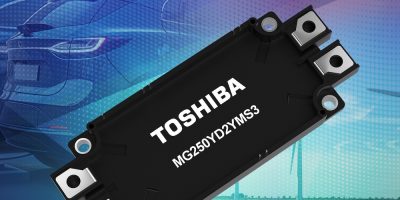2200V SiC MOSFETs enable loss loss, two-level inverters
Dual SiC MOSFET modules are rated at 2200V and designed by Toshiba Electronics Europe as an SiC MOSFET with embedded Schottky barrier diode (SBD). The modules are suitable for use in 1500V DC applications such as photovoltaic (PV) inverters, electric vehicle (EV) chargers, high frequency DC/DC converters and energy storage systems. According to Toshiba, they will simplify inverter designs and increase power density, thereby reducing size and weight.
Two-level inverters have fewer switching modules than three-level versions, making them simpler, smaller and lighter but they require semiconductor devices with a higher breakdown voltage, explained Toshiba Electronics Europe.
The company has developed the MG250YD2YMS3 dual SiC MOSFET module. It has a VDSS rating of 2200V and is capable of supporting a continuous drain current (ID) of 250A, with 500A in pulsed operation (IDP). Isolation (Visol) is rated at 4000V rms and the device can operate at channel temperatures (Tch) as high as 150 degrees C.
In addition, it offers low conduction loss with a typical drain source on-voltage (VDS(on)sense) of 0.7V. Switching losses are minimised with typical turn-on and turn-off losses of 14mJ and 11mJ respectively. These parameters mean that less thermal management is required, resulting in smaller inverters.
Within the MG250YD2YMS3, the impurity concentration and thickness of the drift layer have been optimised to maintain the same relationship between the on-resistance (RDS(on)) and the breakdown voltage as existing products. This also strengthens immunity to cosmic rays, a key requirement for PV systems, Toshiba noted. Embedding SBDs with clamped parasitic PN junctions between the p-base regions and the n-drift layer ensures reliability in reverse conduction conditions.
Switching energy loss for the developed all-SiC module is lower than equivalent silicon modules, confirmed Toshiba. In comparison, the new SiC module achieves double the frequency of a conventional Si IGBT, as well as 37 per cent lower loss when comparing a two-level SiC inverter against a three-level Si inverter.




